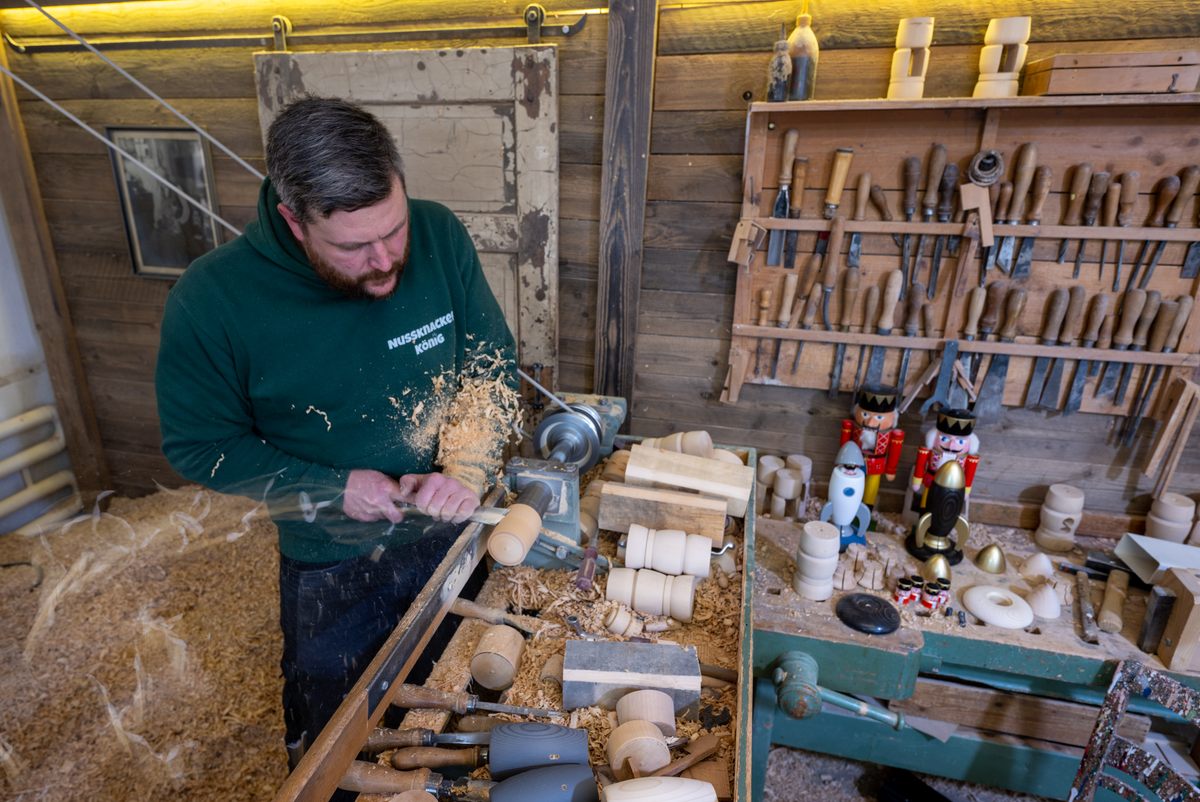The Family Behind the First Traditional Nutcracker Is Still Making Them
Wilhelm Füchtner’s iconic 1870s design began a legacy that continues in the same small workshop in Germany’s Ore Mountains.
Markus Füchtner works the lathe in the workshop that doubles as his home—or maybe it’s his home that doubles as a workshop. The small, one-story building is set in the forested hills of Seiffen, near Germany’s border with Czechia, and has been used by his family of carpenters since 1786. It was here in the early 1870s that his great-great-great-grandfather, Wilhelm Füchtner, made his first nutcracker—and laid the foundation for a global Christmas icon.
Today, Markus Füchtner carries on that tradition, starting at the lathe. Sometimes he uses a foot-controlled antique that he restored in 2022; other times, he relies on a more modern, electric lathe, but his goal is always the same, he says: “I want to approach nutcrackers like in the past: old machines, good wood, and [producing] not many nutcrackers, but good ones.”
Reminders of the Füchtner family legacy are everywhere in the small building: Chisels passed down through the generations line the woodshop walls. In the assembly and painting room, six nutcrackers, each representing a different generation and adorned with a photo of their creator, watch the activity from a shelf.
The soldier-style nutcracker design now known the world over began in this small house in the Ore Mountains. As the name suggests, mining had long dominated the area, but the Füchtner family of carpenters built wooden homes. The work was more seasonal, and dropped off during the long, cold winter. “They needed to live,” says Marcus Füchtner. So, like other local woodcarvers, they created and sold toys and other small, wooden items.

Among those modest items were nutcrackers. Tools to break open nuts have been around since primates first began banging them against rocks, of course, but the earliest examples of instruments designed for the specific task look nothing like the nutcrackers that came marching out of the Füchtner workshop. A bronze and gold nutcracker found in southern Italy and dated to at least the third century BC, for example, is shaped like two forearms with elegant, clasped hands.
The Füchtner nutcrackers, with traditional military-style dress and expressionless faces, reflect the harsh reality of the industrial era in which they emerged, when elites generally enjoyed a comfortable life while workers toiled away, often performing hard physical labor in brutal conditions.
“It was a hard life,” says Füchtner. “There were tensions between the workers and the ruling class.”
Nutcrackers depicting authority figures began appearing in the mid-19th century, during the German Industrial Revolution, as a way to make fun of the ruling class and upend the system by having them “work” for the lower class, cracking nuts.
“The king must be working at Christmastime for the hard-working people, cracking nuts. But the people must work the rest of the year for the king,” says Uwe Löschner, owner of the region’s Nutcracker Museum, referring to the trend.
The earliest soldier-style nutcrackers were carved from a single piece of wood, but Wilhelm Füchtner used multiple pieces fit together with wooden joints, similar to how his carpenter family built houses. This created the distinctive shape of today’s ubiquitous nutcracker.
Although Wilhelm Füchtner innovated the design, he didn’t quit his day job. It wasn’t until three generations later that nutcrackers became a full-time enterprise for the family. “The family’s main profession was carpentry,” says Markus Füchtner. “My grandfather [Werner Füchtner] was the first that could make a living [from nutcrackers].”
While the soldier-style nutcrackers had been a regional tradition in the Ore Mountains for decades, they gained worldwide popularity in the mid-20th century. About the time Werner Füchtner was working his lathe, Tchaikovsky’s “Nutcracker Ballet,” first performed outside Russia in 1934, was becoming a holiday classic, and many Allied soldiers returning home from World War II’s European theater brought the wooden figurines as souvenirs.
Suddenly it seemed the soldier-style nutcrackers were everywhere—except as Füchtner family heirlooms. The family doesn’t have any of their earliest versions. The oldest surviving Füchtner nutcrackers, including one from the early 1870s, can be found at the Erzgebirge museum.
“They didn’t keep anything; they had to sell stuff to survive,” says Füchtner. “Also, when they started making these products, they didn’t know they’d be part of history.”

For his part, Füchtner is continuing that rich history, a legacy he came to out of love. Though he never felt pressured to go into the family business, he and his grandfather were close, and the time spent together made an impression on the young Markus. “When my grandfather passed away, we put a red king nutcracker in his casket,” Füchtner says. “For me, it was a moment to start the next generation.”
At 16, he enrolled in the only school in the world teaching wooden toymaking, which happens to be in Seiffen. It’s where he met his partner, Carola Seifert, who paints the nutcrackers and handles other parts of the business. Füchtner’s parents and an aunt are also involved.
The family workshop produces only about 500 nutcrackers a year. Each one is hand carved and assembled using wooden pegs and glue rather than nails. The figurines are then dipped five times in base color before final details are painted, all by hand, which delights nutcracker enthusiasts.
“Markus should be commended for continuing to make them in the true traditional way, and the workmanship is superb,” says Arlene Wagner, curator of the Leavenworth Nutcracker Museum in Washington state.
The smallest nutcracker Füchtner has created is just 12 centimeters (less than five inches) tall, made for a friend who was planning a trip around the world and wanted to carry something from Germany.
“After he returned, many other people asked to bring it to other places,” Füchtner says. As word of the short-statured, globe-trotting nutcracker spread, the European Space Agency got involved. Made with the purpose of traveling around the world, the mini-nutcracker did just that, spending two years aboard the International Space Station and only recently returning to Earth. The nutcracker’s name? Wilhelm, of course, in honor of the man, five generations earlier, who took the art of making nutcrackers to new heights.


























Follow us on Twitter to get the latest on the world's hidden wonders.
Like us on Facebook to get the latest on the world's hidden wonders.
Follow us on Twitter Like us on Facebook